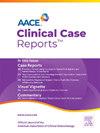Bilateral Adrenal Nodules in the Setting of Disseminated Fungal Infection: An Important Consideration for Appropriate Management of Adrenal Pathology
IF 1.2
Q3 Medicine
引用次数: 0
Abstract
Background/Objective
Increased utilization of cross-sectional imaging has led to a rise in diagnosis of incidental adrenal lesions. Physicians in many clinical settings are increasingly faced with addressing these incidental lesions by initiating the correct workup, diagnosis, and long-term follow-up plan. Our objective was to demonstrate the importance of maintaining a broad differential and completing a thorough workup in determining the correct treatment plan for patients with bilateral adrenal lesions.
Case Report
We present 2 patients who recently completed chemotherapy for lymphoma, found to have new bilateral adrenal lesions on postchemotherapy imaging. Urine antigen and/or adrenal biopsy was performed to confirm the diagnosis of disseminated fungal infection. This diagnosis has major implications on the treatment plan, which includes antifungal therapy instead of surgical management or additional chemotherapy. Cross-sectional imaging after initiation of antifungal treatment demonstrated decreasing size of nodules.
Discussion
A broad differential is critical when working up and developing treatment plans for adrenal nodules, specifically considering a fungal etiology in the setting of immunosuppression or primary extra-adrenal malignancy.
Conclusion
Incidentally found adrenal lesions are becoming more common, and in turn, the obligation for appropriate management of adrenal pathology not only falls to medical and surgical endocrinologists but also to general practitioners. It is prudent to consider atypical etiologies including disseminated fungal infection prior to surgical excision or initiation of chemotherapy as those treatment strategies would not benefit select patients.
播散性真菌感染的双侧肾上腺结节:肾上腺病理适当处理的重要考虑
背景/目的横断成像的应用增加了偶发性肾上腺病变的诊断率。在许多临床环境中,医生越来越多地面临着通过启动正确的检查、诊断和长期随访计划来解决这些偶然病变的问题。我们的目的是证明在确定双侧肾上腺病变患者的正确治疗方案时,保持广泛的鉴别和完成彻底的检查的重要性。病例报告:我们报告了2例最近完成淋巴瘤化疗的患者,化疗后影像学发现双侧肾上腺有新的病变。尿抗原和/或肾上腺活检证实弥散性真菌感染的诊断。这一诊断对治疗计划有重要意义,包括抗真菌治疗而不是手术治疗或额外的化疗。开始抗真菌治疗后的横断面成像显示结节变小。在制定和制定肾上腺结节的治疗计划时,特别是考虑到免疫抑制或原发性肾上腺外恶性肿瘤的真菌病因,广泛的区分是至关重要的。结论偶然发现的肾上腺病变越来越多,对肾上腺病理进行适当管理的责任不仅落在内科和外科内分泌科医师身上,也落在全科医生身上。谨慎考虑非典型病因,包括手术切除或化疗开始前的播散性真菌感染,因为这些治疗策略不会使选定的患者受益。
本文章由计算机程序翻译,如有差异,请以英文原文为准。
求助全文
约1分钟内获得全文
求助全文
来源期刊

AACE Clinical Case Reports
Medicine-Endocrinology, Diabetes and Metabolism
CiteScore
2.30
自引率
0.00%
发文量
61
审稿时长
55 days
 求助内容:
求助内容: 应助结果提醒方式:
应助结果提醒方式:


